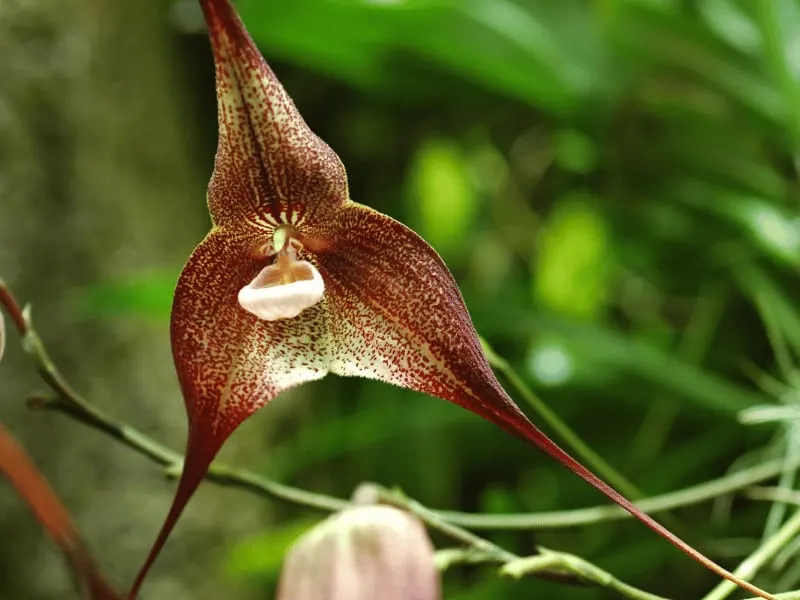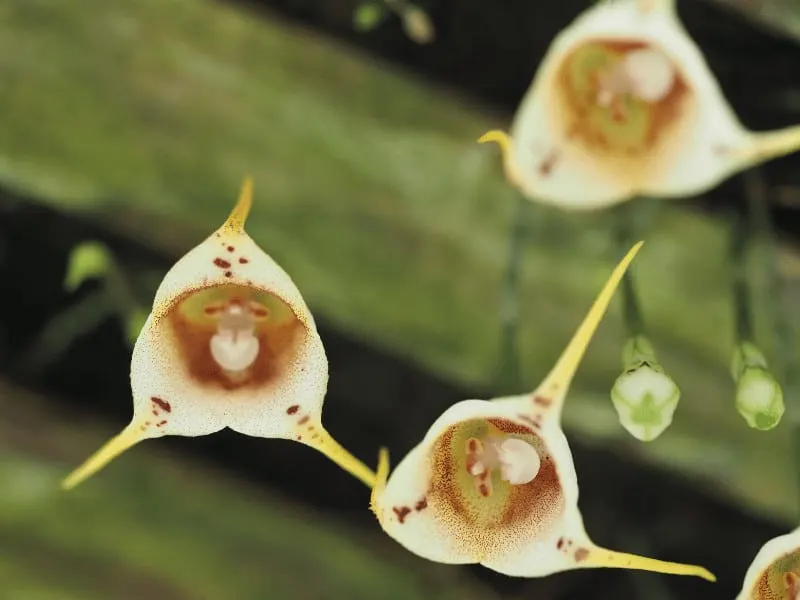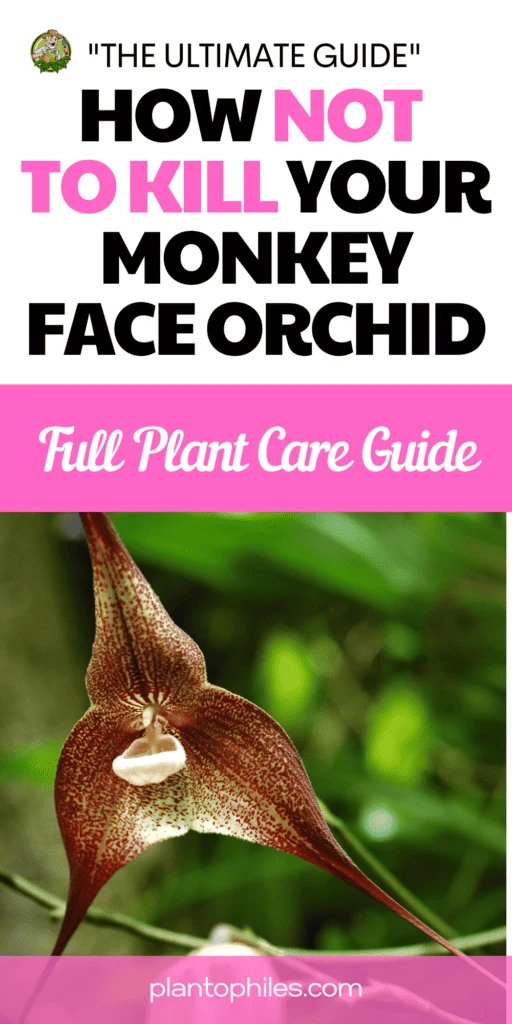(image credits: IG Evelyn (@wild_evi))
You came to this site to learn more about the Monkey Face Orchid (Dracula simia) and see pictures. You might even want to care for a Monkey Face Orchid and need more information about soil, temperature, humidity, and fertilizer.
The Monkey Face Orchid is real!
Monkey face Orchids are difficult to care for and have specific growing conditions.

Monkey Face Orchid Plant (Dracula simia)
As the name implies, this fabulous orchid has a flower with uniquely shaped petals and a center that resembles a cheeky, grinning monkey face. They are fun and adorable and sure to put a smile on your face whenever you look at them.
For those who love complex names – the Latin name for monkey face orchids is Dracula simia.
They are native to Ecuador and Peru in South America. These forests are, on average 3,200 feet to 6,500 feet (1,000m to 2,000m) above sea level.
Read on for a detailed guide on how to grow monkey face orchids in your home or greenhouse.
Monkey Face Orchid Facts
| Species | Dracula simia |
| Synonyms | Monkey Face Orchid, Monkey Orchid, and Monkey-like Dracula |
| Family | Orchidaceae |
| Genus | Dracula |
| Growth | Epiphytic, compact |
| Height | 0.8 foot |
| Width | 0.5 feet |
| Soil | Well-draining potting mix using fir bark, coconut husk chips, or perlite, chopped-up sphagnum moss, charcoal |
| Watering | Every 7-10 days |
| Light | Bright indirect |
| Temperature | 60-75 °F to 90 °F (16-24 °C) |
| Humidity | 50-70% |
| Fertilizer | Fertilize weekly spring and summer |
| Propagation | Division of pseudobulbs or by seed |
| Toxicity | This plant is toxic to cats and dogs as well as humans. |
Table of Contents
Monkey Face Orchid For Sale
You can buy live Monkey Face Orchids plants from the following online stores:
Monkey Face Orchid Seeds
You can buy Monkey Face Orchid seeds here:
- Monkey Face Orchid seeds from Etsy (beware of scams and verify the authenticity of the seeds before buying)
The Monkey Face Orchid Flower
The Monkey Face Orchid flower resembles a monkey’s face. Hence the name. The flower is between 2-6 inches long, according to Orchid Species Encyclopedia.
Monkey face orchids wow with unique flowers resembling Simian monkeys with drooping Dracula fangs. They come in many shades, including red, green, yellow, pink, purple, and lavender. A plant will flower through the year for up to 19 years under the correct conditions.
The flower petals are large. The bract itself is small. The inflorescence emits a nice scent resembling ripe oranges.

Monkey Face Orchid Care
Plant a Monkey Face orchid in a special orchid mix. Provide cool, damp, shady, and humid conditions. Ideal temperatures are between 60°F to 75°F (16°C to 24°C). Your containers must allow for adequate drainage. Watering and mist spraying is vital, and feeding can be done weekly.

What soil is best for a Dracula simia?
Monkey face orchids cannot be grown in normal potting soil. They require a specific orchid mix that has a chunky consistency. You can purchase this mix or make it yourself using fir bark, perlite, and sphagnum moss. PH levels should be acidic to neutral, ranging from 5.5 to 7.0.
Monkey face orchids cannot be planted into your normal potting soil. They require very specific soil conditions.
The ideal type of soil for monkey face orchids is orchid-specific soil. Orchid soil does not contain soil or sand but comprises a combination of chunky ingredients close to its natural environment.
You can buy orchid soil at your local nursery if they are geared up for these specific plants. It is also sold at farmer’s markets and online.
If you want to make your own orchid soil, you can try a few recipes.
This one is easy to make:
- 4 parts fir bark
- 1 part coconut husk chips or perlite
- 1 part chopped-up sphagnum moss
- 1 part medium charcoal
Read more about where to buy orchid bark here.
Some gardeners make up this mix without the charcoal. It is up to you.
The mix has to be very well-draining. Water must not accumulate at the base of your pot. To help with this, I like to place small pebbles or bits of a broken terracotta pot at the base.
Monkey face orchids prefer soil that is acidic to neutral. Testing the PH balance of your potting soil mix is easy with a home testing PH kit.
Neutral soils have a PH of 7.0. Acidic soils show a value of less than 7.0, and alkaline soils over 7.0. monkey face orchids do best in soils with a PH range of 5.5 to 7.0.
What Light is best for a Monkey Face Orchid
Monkey face orchids grow naturally in dim, cool misty conditions. They do not enjoy the sun. Keep yours in a cool dark spot or full shade. You do not need to place it near a window to get direct sun as it will damage the plant. Bright light is also not essential.
Monkey face orchids grow in very high cloud forests with dim light conditions. There is very little direct sunlight.
You need to create the same environment for your plant to flourish. Place it in a spot that is shady and cool. If it is indoors, you do not need to worry about it getting any sun during the day. So, unlike other plants, it does not need to stand close to a window. A darker spot is ideal.
If you are growing your plant outdoors, a spot with full shade is ideal. A north-facing patio will be fine, provided the plant is protected from the elements.
Growing your plant outdoors is more difficult than growing it indoors, where you have better control over the conditions.
Check that your Monkey Face Orchid leaves are cool to the touch. This Orchid can suffer damage if it is in the sun and feels warm.
Watering
Monkey face orchids must remain damp but should not be overwatered. Water once every 7 days and mist spray regularly to keep the plant damp and cool. Do not use tap water. Rainwater or cooled boiled water is preferred. Choose a pot with drainage holes at the base and on the sides.
To recreate the damp misty conditions of its natural habitat, you should water your monkey face orchid once a week by giving it a good drench.
Try to use natural rainwater if possible. Tap water has chemicals that are foreign to these very fragile plants. The build-up of chemicals will eventually cause damage to your plant. If you do not have easy access to rainwater, use cooled boiled water or distilled water that you can purchase from a store.
The most important fact to remember is that these plants require air circulation. You can buy special pots for orchids with drainage holes at the base and sides. This allows for maximum circulation and also allows the water to drain out.
Getting the correct moisture balance is vital. The plant must never dry out but must also not stand in wet soggy soil. That will cause root rot, and your plant will die.
Water your monkey face orchid in the morning, and do not overwater.
A great method for watering orchids is to fill a large container with rainwater or distilled water. Then place your orchid in its pot into the container. The water level should not flood into the pot! Allow it to stand for 15 minutes. Lift the pot out of the water bath and let all excess water drain.
What is the ideal Temperature for a Monkey Face Orchid?
This plant does not respond well to temperatures that fluctuate or are too hot. Ideal temperatures are between 42°F to 46°F (6°C to 8°C) and 66°F to 68°F (19°C to 20°C). Do not stand your plant in a draught or directly in front of an air conditioner.
Because the natural habitat of this plant is cooler in high regions, your monkey face orchid does not want hot temperatures.
Ensure that your indoor plant has temperatures that are between 42°F to 46°F (6°C to 8°C) and 66°F to 68°F (19°C to 20°C)
To get the perfect conditions, you may consider growing your plant in a small greenhouse where you have better control over the environment. This plant does not enjoy temperatures that fluctuate too much.
Do not place it in the draught of an open window or directly in front of the breeze from an air conditioner.
As you can see, this is a very fussy plant that requires much care!
The ideal Humidity Range
Monkey face orchids require very humid conditions of 80 percent or over. It is important to mist spray your plant daily to keep it damp and moist. Do not spray the flowers directly. You can create the best conditions in a greenhouse or a small indoor plastic container.
Monkey face orchids require very humid conditions to flourish. Their natural habitat is cool mist forests where they are always damp.
The ideal humidity should be above 80 percent. An average home will range from 40 percent to 50 percent.
Creating these conditions may be difficult indoors.
Growing your plant in a greenhouse is ideal but not possible for everyone. Remember that creating an area of high humidity in your home can lead to mold and bacteria growth. So some thought and planning will be required to set up the best spot for your plant.
You could consider creating a mini greenhouse indoors using a plastic box. Many helpful videos on the internet show you how to do this. You can also purchase mini greenhouse boxes that are ideal for growing orchids.
One way to increase humidity for your plant is to place shallow bowls of water around it.
Mist spraying is a must! Spray the plant daily to keep it damp. Make sure that you do not spray the flowers directly.
Fertilizing
Choose a 20-20-20 balanced formula of nitrogen, phosphorus, and potassium. Feed weekly with a diluted solution or monthly with a standard solution. Do not feed when the soil or roots are dry. Do not give your plant excess nitrogen, as it will damage the roots.
The best fertilizer for your monkey face orchid is a 20-20-20 mix. These numbers indicate the mix’s nitrogen, phosphorus, and potassium ratios. As you can see, the mix perfectly balances all three.
Monkey face orchids do not like too much nitrogen. Do not feed them with a high nitrogen component fertilizer, as it will harm the plant.
Feeding can be done weekly or monthly.
If you are feeding weekly, use a weak, diluted solution. For monthly feeding, mix, and use according to the standard instructions on the package.
Ensure that the soil and roots are wet before adding fertilizer. If not, it will burn and destroy the roots.
Never over-fertilize!
When to plant your monkey face orchid
Monkey face orchids can be planted any time of the year. Because you control the environment, you do not need to worry about outside influences like seasons, temperature, or humidity.
Provided that your indoor conditions are ideal, you can plant your monkey face orchid any time of the year.
Ensure that the temperatures do not fluctuate. Humidity must be above 80 percent. Ensure that your chosen spot is out of direct sunlight and is cool, damp, and shady. The shade of a closet is too dark! Your plant does enjoy a little bit of light.
How to plant your monkey face orchid (Potting and Repotting)
Choose a pot with drainage holes on the base and sides. Sterilize all your tools before starting. Fill the pot with an orchid mix and add fertilizer. Gently place the orchid into the mix. Mist spray and water daily for the first week. Stand it in a very humid, cool, shady spot.
Preparation is key when planting or repot a monkey face orchid. You need humid greenhouse-type conditions that do not fluctuate too much in temperature.
If you do not have a greenhouse, consider setting up a small indoor container resembling a greenhouse.
Start by sterilizing all your tools and wear clean gloves to protect the plant.
Choose a pot with drainage holes on the sides and at the base. This is vital for correct drainage and air circulation. Place some pebbles or broken terracotta shards at the base to help drainage.
Fill your pot with the orchid mix and water well. Add a diluted solution of 20-20-20 fertilizer. Make a shallow hole in the center of the new pot.
Very gently remove the plant from its bought container or current container. Check for any damaged or dead roots and trim them off.
Place the plant into the new pot working with light fingers. Do not plant it too deep into the soil. Fill in the hole with additional orchid mix. Do not press the mix down tight, it must remain loose and aerated.
You can use a stake to hold up a new plant if it needs support.
Mist spray and water well. Allow the excess water to drain out. Stand it in its new home. Mist spray daily and water well for the first week. Do not fiddle too much with this plant. It is fragile and very fussy.
Sieh dir diesen Beitrag auf Instagram an
Monkey Face Orchid problems
Flowers collapse
This is a sign that your humidity is too low. Increase it if possible. You can place open bowls of water around the plant and mist-spray it daily to try to get it to recover.
Roots are rooting
This is caused by water not draining out of your container fast enough. The roots of the monkey face orchid should be damp but never stand in stagnant water. Choose a pot with drainage holes on the sides and base. Ensure that your soil is a correct orchid mix.
Roots are white and not green
This indicates that you are not giving your plant enough water. Green roots indicate a healthy plant. White or silvery-colored roots mean you need to water it more frequently.
Frequently Asked Questions
Is the Monkey face orchid easy to grow?
Monkey face orchids are not the easiest plants to grow, but that does not mean you shouldn’t give it a try. If you spend time setting up the correct environment, you will be rewarded with stunning flowers from this unique plant.
Can the Monkey face orchid grow outdoors?
It can, but the conditions have to be perfect. Its natural habitat is high cloud forests that are cool, damp, and dimly lit. Growing a monkey face orchid indoors or in a greenhouse gives you a better chance of creating the perfect conditions for it to flourish.
Can I propagate monkey face orchids?
Propagation of monkey face orchids is very difficult. Many websites claim to sell monkey face seeds. But, people report that they are not the real thing.
If you can find a mature plant at a nursery, or get one from a green-fingered friend, that is probably the best way to acquire one.

Daniel has been a plant enthusiast for over 20 years. He owns hundreds of houseplants and prepares for the chili growing seasons yearly with great anticipation. His favorite plants are plant species in the Araceae family, such as Monstera, Philodendron, and Anthurium. He also loves gardening and is growing hot peppers, tomatoes, and many more vegetables.


